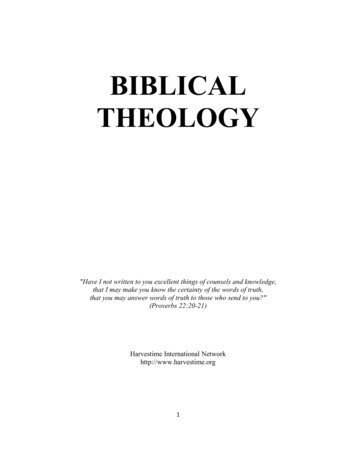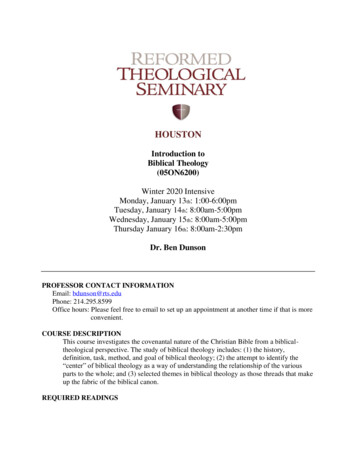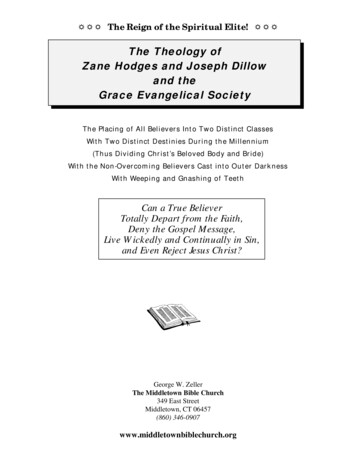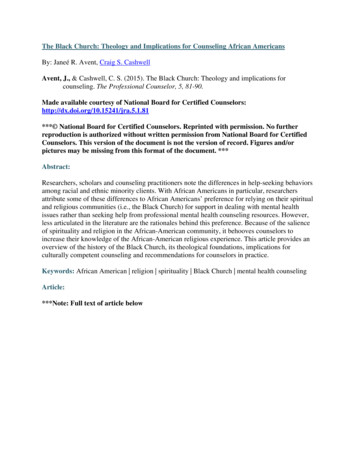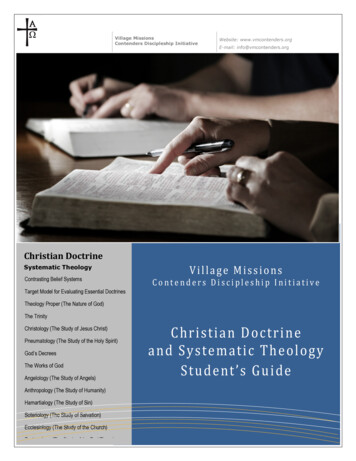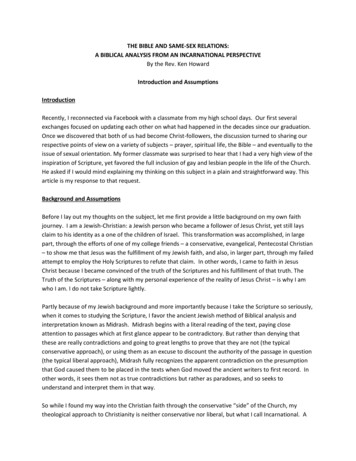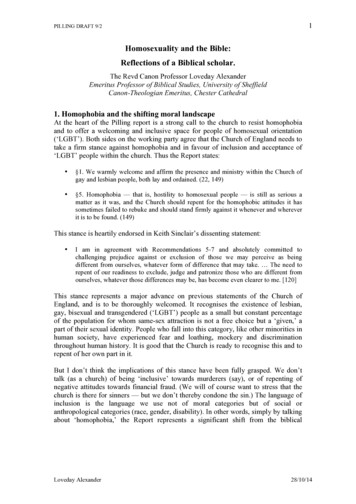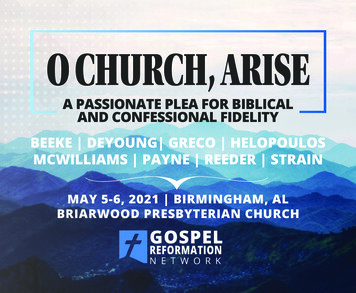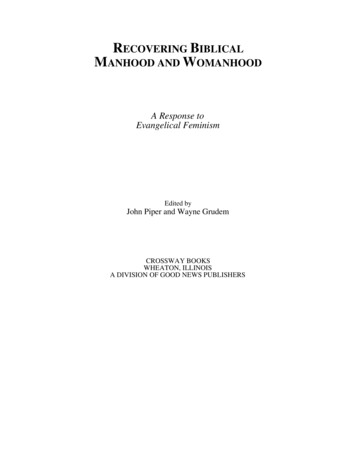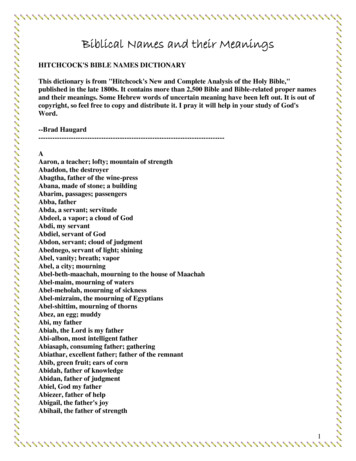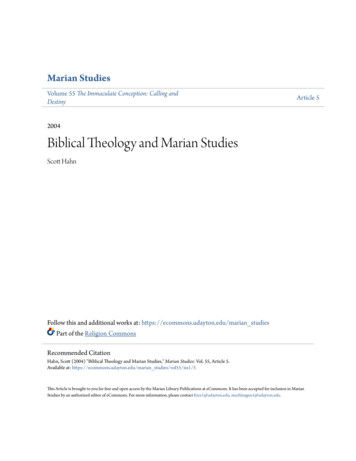
Transcription
Marian StudiesVolume 55 The Immaculate Conception: Calling andDestinyArticle 52004Biblical Theology and Marian StudiesScott HahnFollow this and additional works at: https://ecommons.udayton.edu/marian studiesPart of the Religion CommonsRecommended CitationHahn, Scott (2004) "Biblical Theology and Marian Studies," Marian Studies: Vol. 55, Article 5.Available at: https://ecommons.udayton.edu/marian studies/vol55/iss1/5This Article is brought to you for free and open access by the Marian Library Publications at eCommons. It has been accepted for inclusion in MarianStudies by an authorized editor of eCommons. For more information, please contact frice1@udayton.edu, mschlangen1@udayton.edu.
Hahn: Biblical Theology and Marian StudiesBmuCAL THEoLOGY ANDMAruANSTUDIESScott Hahn, Ph.D.*As we consider Mary from many points of view, it can sometimes seem as if we are studying many models of Mary-a collection of constructs, rather than a person. In Mariology, noless than in secular academia, zeal for our specializations canconsume us. We can succumb to the disease that JacquesBarzun calls "specialism" -the "pedantic, miser-like heapingup" of relatively trivial knowledge in our narrow, isolatedfields. Barzun complains that, today, "The expert takes a littlesubject for his province-and remains provincial all his life:' 1This is the lot of those of us who pursued our studies in the1970s, '80s, and '90s. Such are the provinces to which our advisors and our dissertation committees led us. Yet, somehow,out there in our provinces, something else led us, or drew us,to Miryam of Nazareth-a woman of the provinces. And, inmeeting her, a whole world opened up to our eyes. For, in her,more than almost any other human subject, the provincial becomes universal. In this peasant woman, the parochial becomes most literally and most truly catholic.Perhaps it is because Mary is the very archetype of motherhood, and it is every mother's job to gather her scattered children. But ever has it been this way: Mary is the hope of thepoor. Her icon is the catechism of the unlettered. Yet Marymarks also the pinnacle of culture: the centerpiece of royal tapestries and the ornament of aristocratic drawing rooms. It isMary who inspires both encyclopedias and novenas. Roman scott Hahn is professor of theology at the Franciscan University of Steubenville,founder and president of the St. Paul Center for Biblical Theology, and a major contributor to the Ignatius Catholic Study Bible.1 Jacques Barzun, The Culture We Deserve: A Critique of Dlsenllgbtemnent(Middletown, Cf.: Wesleyan University Press, 1989), 6-7.LV (2004)Published by eCommons, 2004MARIAN STUDIES9-321
Marian Studies, Vol. 55 [2004], Art. 510Biblical Theology and Marian StudiesCatholics call her Mater Ecclesiae, Mother of the Church, andit is a big Church after all.For this reason and many others, I believe that Mariology,perhaps more than any other field, can provide an antidote tothe theological strains of Barzun's Syndrome-a cure forchronic, idiopathic, systemic, debilitating, degenerative specialism. And make no mistake: theology has all-too-willingly followed the trend of secular academia and fragmented intoprovincial disciplines, each working in isolation from all theothers. Dogmatic theologians may now assume they have nothing to learn from biblical scholars. Exegetes, for their part, givescant consideration to the insights of systematic and dogmatictheologians. To many scholars, these disciplines are almostcontradictory: exegesis is opposed to dogma, and vice-versa.I do not wish to be a callow critic. I speak in strong terms,because I am making my confession. I am, after all, a Catholicprofessor of theology-a doctor of Catholic dogma-who wasonce trained in the rigors of both Protestant systematic theology and Protestant biblical exegesis. Believe me, I know theprovinces because I have always lived in the provinces.But Mariology offers my colleagues and me a way out intothat wider world, that catholic vision. Mariology can gatherthe scattered disciplines by modeling an integrative, holisticapproach. I believe that Mariology is especially well-suited tothe recovery of a biblical theology-a biblical theology that integrates such diffuse and disparate fields as dogma, exegesis,and liturgy.There are many misconceptions about how biblical theology differs from systematic theology. It is not as if a systematictheologian is bound by logic, while a biblical theologian is freeto be illogical and unsystematic. Rather, the ordering principlebehind systematic theology is the logical progression of thedoctrines of theology, whereas the ordering principle behindbiblical theology is the divine economy. In salvation history,the biblical theologian recognizes an order, a plan that reflectsthe divine pedagogy of God fathering His family. It is a different systematic ordering principle, but it is no less systematic.Biblical theology is more than simply one of many possiblemethods for reading the Bible. It is, in fact, the way our me-https://ecommons.udayton.edu/marian studies/vol55/iss1/52
Hahn: Biblical Theology and Marian StudiesBiblical Theology and Marian Studies11dieval, patristic, and apostolic ancestors lived and preachedand had their being. And it is the way the Magisterium of theCatholic Church asks that Scripture be studied today. Theguidelines from the Sacred Congregation for Catholic Education's On the Theological Formation of Future Priests concluded: "After the introductory questions have been handled,the teaching of Sacred Scripture must culminate in a biblicaltheology which gives a unified vision of the Christian mystery."2 Note that such an integrated approach is the necessaryculmination of theological study-not an elective, not a specialty. It is a way out of the provinces and into a unified, universal "vision of the Christian mystery:' Similarly, Vatican IIstated: "For the Sacred Scriptures contain the word of God andsince they are spired really are the word of God; and so thestudy of the sacred page is, as it were, the soul of sacred theology" (Dei Verbum, 24).A Mariology that follows these principles-a biblical theology of Mary-is a discipline worthy of our calling. For surely itwas not by accident or coincidence that we entered this field,but by vocation. A biblical theology of Mary is worthy of ourcalling and capable of reviving the fires of our ftrst love.A biblical theology of Mary makes us one with the evangelists, the Fathers, the medieval commentators, and Christiansthrough the centuries who have been drawn away from theirsmall interests-not by a collection of constructs, not by an accumulation of hypotheses, not by a dispute or by a dogmabut by Mary, the Blessed Virgin Mother of the Messiah. Abiblical theology of Mary takes us back to the theo-logoi-theinspired word of God, set down by the primordial theologians.According to many great Christians, from Pseudo-Denis toBonaventure to Joseph Ratzinger, biblical writers are the mostworthy of the name "theologians." A biblical theology of Marylifts us out of the habit of what I call "theologian-ology" -asfascinating as that can be-and compels us to confront thecanonical wellsprings of all Marian doctrine and devotion.2 Sacred Congregation for Catholic Education, The Theological Fonnatton ofFuture Priests (February 22, 1976), as quoted in The Pope Speaks 21 (1976): 365-66.Published by eCommons, 20043
Marian Studies, Vol. 55 [2004], Art. 512Biblical Theology and Marian StudiesThis approach does demand our serious engagement of thebiblical canon, and that means both testaments. Dei Verbuminstructed us to "be especially attentive 'to the content andunity of the whole Scripture;" and this instruction was repeated verbatim in the Catechism ofthe Catholic Church (DV, 12;Catechism, no. 112).Our attention "to the content and unity of the whole Scripture" leads us logically to a typological reading. Typology is anessential element in our biblical theology of Mary, and we neednot shrink from it. It is superfluous for me to say that typologyis integral to the patristic and medieval methods of exegesisand theology. It is self-evident that typology is the naturalmode of understanding for the New Testament authors (andJesus Himself), all of whom understood the entire Old Testament as inseparable from the Gospel they proclaimed. SaintPaul described Adam as a "type" of]esus Christ (Rom. 5: 14). Itis no news that typology is endorsed by the Catechism of theCatholic Church.Still, many modern interpreters are uneasy with typology.They worry about its potential for latent anti-Semitism andanti-Judaism. They worry about the dark recesses and historical excesses of supercessionism. So they turn a blind eye to allthings typological and sever all ties that bind the two testaments. They read typology out of theology, exegesis, and evenScripture itself. Of such interpreters, a great scholar of the Hebrew Scriptures, John]. Collins, wrote that "the ecumenical intentions" of their claims are "transparent and honorable, butalso misguided" since their claims are "so plainly false."3Indeed, a cursory reading of the Old Testament should showthat typological method predates Christianity by many centuries. Isaiah used it to prepare Israel for the coming savior. Andhis three motifs were the three motifs most zealously adoptedby the New Testament authors and their successors. Again andagain, Isaiah evokes creation, exodus, and the establishment ofthe kingdom of God, through God's covenant with the house3 John]. Collins, The Scepter and the Star: The Messiahs of the Dead Sea Scrollsand Other An dent Literature (New York: Doubleday, 1995), 2.https://ecommons.udayton.edu/marian studies/vol55/iss1/54
Hahn: Biblical Theology and Marian StudiesBiblical Theology and Marian Studies13of David and his dynastic heirs. Isaiah looks, simultaneously,back to these events and forward to their glorious reprise, in anew creation, a new exodus, a lasting kingdom.Isaiah, moreover, is not alone in doing this. Ezekiel and Jeremiah employ a similar typological method, focusing on thesame three pivotal moments in salvation history. It is the OldTestament prophets who inspired jean Danielou's famous definition of prophecy as the typological interpretation of history. 4Why do the Scriptures work this way? Why does history unfold typologically? Saint Augustine explained that ordinaryhuman writers use words to signify things; but God uses evencreated things to signify things. So not only are the words ofScripture signs of things that happened in history, but the veryevents of sacred history were fashioned by God as materialsigns that show us immaterial realities-temporal events thatdisclose eternal truths. God writes the world the way menwrite words (see Catechism, nos. 116-17).Thus we can read the Scriptures at once as a kind of divinepoetry and as the sacred history of the world. The two are notincompatible. As Mark Twain once observed: "History doesn'trepeat itself, but it does rhyme a lot:' In typology, we discoverGod's rhyme scheme in history.What has all this to do with dogma, much less dogmatic theology? Now is a good time for us to address their interrelationdirectly. Cardinal Ratzinger has put the matter succinctly.Dogma, he says, "is by defmition nothing other than an interpretation of Scripture."5 His insight has been confirmed by the1989 document of the International Theological Commission,On the Interpretation of Dogmas: "In the dogma of theChurch, one is thus concerned with the correct interpretation ofthe Scriptures:'6 Dogma, then, is the Church's infallible exegesis,4 jean Danielou, The Bible and the Liturgy (Notre Dame, IN: University of NotreDame Press, 1956).5 joseph Cardinal Ratzinger, "Crisis in Catechetics," Canadian Catholic Review(June 1983): 178.6 International Theological Commission, On the Interpretation ofDogmas (1989),as quoted in Origins 20 (May 17, 1990): 10.Published by eCommons, 20045
Marian Studies, Vol. 55 [2004], Art. 514Biblical Theology and Marian Studiesand dogmatic theology is a reflection upon that work. This,then, is the end of specialism. Dogma is dependent on exegesis. Indeed, dogma is nothing less than exegesis, confirmed authoritatively by Tradition and the Church.Well, I said this was a confession, and I must confess now thatI have gone too far into this address without practicing what Ipreach. Now I wish to show from biblical theology how theMarian dogmas are statements founded in the Scripture. I propose to trace three Old Testament types to their New Testamentantitypes and then, further, to their definitive interpretation asdogmas of the Church. At three most pivotal moments-creation, the Exodus, and the establishment of the kingdom ofDavid-salvation history presents types of the Virgin Mary toaccompany principal typological anticipations of Jesus Christ.These types are revealed, in remarkable detail, in their New Testament fulftllment. Moreover, I propose that the Church's mostimportant Marian dogmas are best understood as authoritativeexegeses of those biblical texts. 7 Three types, three antitypes,three dogmas: that is ambitious, I admit. So I will begin wherea biblical theologian should-in the beginning.The early Christians considered the beginning of Genesiswith its story of creation and Fall and its promise of redemptionto be so christological in its implications that they called it theProtoevangelium, or "First Gospel." While this theme is explicit in Paul and the Church Fathers, it is implied throughoutthe New Testament. For example, like Adam, Jesus was testedin a garden-the Garden of Gethsemane (Mt. 26:36-46). LikeAdam, Jesus was led to a "tree;' where He was stripped naked(Mt. 27:31). Like Adam, He fell into the deep sleep of death, sothat from His side would come forth the New Eve Gn. 19:26-35; cf. 1 Jn. 5:6-8), His bride, the Church.The motif of the New Adam is nowhere so artfully developed as in the Fourth Gospel. The evangeli
scott Hahn is professor of theology at the Franciscan University of Steubenville, founder and president of the St. Paul Center for Biblical Theology, and a major con tributor to the Ignatius Catholic Study Bible. 1 Jacques Barzun, The Culture We Deserve: A Critique of Dlsenllgbtemnent (Middletown, Cf.: Wesleyan University Press, 1989), 6-7. LV (2004) MARIAN STUDIES 9-32 1 Hahn: Biblical .
